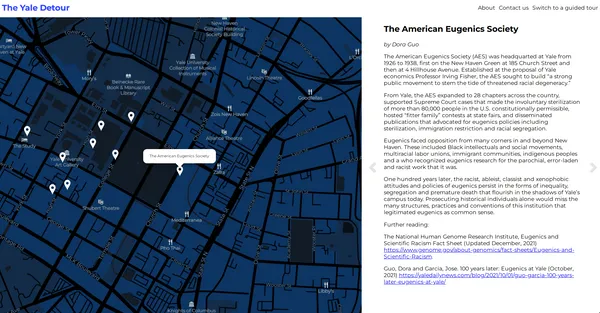
About#🠑
For the past few months I’ve been working with some friends on a project we’ve been calling the Yale Detour. The project is an attempt to think about how Yale’s history as a colonial institution remains embedded in its architecture and landscape in the present-day, and to highlight sites where Yale students and New Haven residents have changed the course of the university’s history through remarkable moments of struggle. This project presents this through an interactive map.
This project is adapted from an in-person tour developed by Esul Burton and Janis Jin in Summer 2019 for the Cultural Connections pre-orientation program at Yale. At that time, the project was called the “Yale Critical History Tour.” Since then, the project has expanded somewhat in scope due to work from students in Professor Talya Zemach-Bersin’s Fall 2020 interation of the seminar Education and Empire. Editors Amy Kim and Jose Garcia, along with Mia Coates, Mona Mahadevan, Blanca Tallaj, Natalie Troy, Juma Sei, and Sasha Lee, created a zine titled “The Yale Detour.” This zine can be seen on Flipsnack here.
These two tours (or “detours”) were developed separately, but they have very similar goals. These histories pushed back against the cheery versions of Yale history spread by vetted and trained student employees on Yale’s official tour guides. Rather than being remnants or artifacts of the past, these histories are ongoing ones that Yale refuses to denounce and even enthusiastically carries forth, from the takeover and management of the “Shops on Broadway” (a Yale designation) to the funding and namesake of the Schwarzman Center that opened in 2021. These histories aren’t lessons from Yale’s past that we can learn from, but a story of an ongoing struggle; a colonial history of the present. Esul and Janis, joined by Collin Bentley, began developing a interactive, digital version of the Yale Critical History Tour in 2020. This digital version was eventually continued by myself (Nathan Kim), Resty Fufunan, Dora Guo, Amy Kim, and Jose Garcia as the Yale Detour.
Implementation#🠑
My main contribution to this project was building out the technical architecture used for the site.1 Janis suggested to me the possibility of continuing the work she, Esul, and Collin had begun. I was first a bit unsure because I had very little experience with web development at the time, but enthusiastically accepted after a summer of working with the Anti-Eviction Mapping Project and learning React and other web technologies while doing so.
The initial site was built using Mapbox GL for the map component, React as its component system, Netlify as a content management system, and Bootstrap as a styling system. This was thanks to the work of Collin Bentley. That worked really well, and sporadically throughout Fall 2021 I expanded on that and focused on making the map zoom work well, adjusting the map style, making the carousel component work correctly, and other features.
At the end of the semester, I had learned quite a bit more about web development in general and more importantly had cemented a few principles that I felt made for more sustainable web development, both for the developer and for the end user. So I rewrote the site to use Leaflet as the map component, using Svelte as the component architecture, and writing sites in raw markdown with the assistance of Gitlab’s wiki system. With wireframes contributed by our designer Dora Guo, I also redid our styling system to not depend on any third party-dependencies. I felt that this was more minimal, offered more control to the developer, cut down the bundle size from ~300kB to ~30kB with only a single dependency (leaflet), and overall just felt like the correct solution. More important than those sort of quality-of-life and performance benefits, this structure offers ownership to the builders of the Yale Detour, and that was the most important ideal to me.
More details can be found on our Gitlab wiki, which contains details about our technical process and contributor guidelines.
- I also served as a sort of general coordinator, but that process was informal and disorganized enough so I will not elaborate on it here. ↩